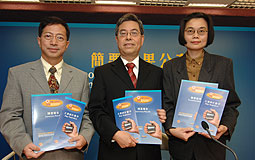
|
| Trend seekers: Deputy Commissioner for Census & Statistics Dominic Leung, Commissioner Fung Hing-wang, and Assistant Commissioner Chan Ka-lin unveil the 2006 Population By-census report. |
The ageing trend in Hong Kong's population continued during the past 10 years, with the median age rising from 34 in 1996 to 39 in 2006, according to the 2006 Population By-census results.
Speaking at a press conference this afternoon, Commissioner for Census & Statistics Fung Hing-wang attributed this to the continuing low fertility rate and mortality improvement over the period.
Anticipating that the ageing pace will accelerate in 2015 or 2016, Mr Fung said about 27% of Hong Kong's population will reach the age of 65 or above in 2030s.
Hong Kong's resident population was 6,864,000 in mid-July 2006. Of this total, 6,645,000 were usual residents and 219,000 were mobile residents.
The sex ratio has fallen from 1,000 men per 1,000 women in 1996, to 911 in 2006. The corresponding sex ratios after excluding foreign domestic helpers were 1,037 men per 1,000 women in 1996, and 961 men per 1,000 women in 2006.
Higher percentage of population ties the knot
The proportion of never-married people among the male population of age 15 and over dropped from 34.2% in 1996 to 33.9% in 2001, but rose to 34.3% in 2006. The figure for women was 28.9% in 1996, rising to 30.1% in 2001 and to 30.7% in 2006.
About 95% of the population were of Chinese ethnicity. The largest non-Chinese ethnic groups in Hong Kong were Filipinos and Indonesians.
Cantonese was the most commonly used language/dialect at home for about 91% of the population aged 5 and over. Another 6% claimed they could speak the dialect. About 40% of the population claimed to speak Putonghua as the usual language, or to be able to speak it.
The educational level of the population has improved. The proportion of the population aged 15 and over with secondary or higher education increased from 68% in 1996 to 75% in 2006. The proportion of those with post-secondary education in degree courses or above also increased significantly, from 10% to 15%.
About 81% of students studying full-time courses in schools or educational institutions in Hong Kong attended schools in the same area as their residence. About 34% of students walked to school.
Labour force swells
Mr Fung said the labour force grew from 3.2 million in 1996 to 3.6 million in 2006, despite a drop in the overall labour-force participation rate from 63% to 60%. This was mainly due to the increase in population size and the changes in the population's age-sex structure.
In 2006, about 33% of the working population were managers, administrators, professionals and associate professionals, up from 29% in 1996. The proportion of the working population engaged as craft and related workers dropped from 12% in 1996 to 8% in 2006.
"Wholesale, retail and import/export trades, restaurants and hotels" and "Community, social and personal services" were the largest economic sectors, each employing about 27% of the working population.
The median monthly income from main employment of the working population was $10,000 in 2006, representing an increase of 5% over the past 10 years. In the same period, prices dropped 2%, as measured by the Composite Consumer Price Index.
Over the last decade, the number of domestic households increased 20% from 1.86 million to 2.23 million. As it increased at a faster rate than the population, the average household size shrunk from 3.3 to 3.
Median monthly income dips
Domestic households' median monthly income was $17,250, representing a 1% dip over that of 10 years ago.
About 3.4 million people lived in private permanent housing, 2.1 million in public rental housing and 1.2 million in subsidised sale flats.
There were 1.17 million households that owned the quarters in which they lived. Among these households, 52% did not need to pay any mortgage nor loan repayment.
Owner-occupiers living in private permanent housing with mortgages or loan repayments incurred a median monthly payment of $9,500, and the ratio of median mortgage payment and loan repayment to income was 29%.
Domestic households renting whole private housing units paid a median monthly rent of $5,500. Those living in public rental housing paid less, with a median monthly rent of $1,390.
Internal population migration
Mr Fung said there was substantial internal migration of the population during the last decade. While 10 years ago, Hong Kong Island, Kowloon and the New Territories had respectively 21%, 32% and 47% of the population, the respective proportions were now 18%, 29% and 52%.
"Many districts in the New Territories such as Islands, Sai Kung and Yuen Long recorded a marked population growth because of new towns development, whereas districts like Wan Chai, Southern and Kowloon City experienced population decreases," Mr Fung said.
Among the District Council districts, Yuen Long had the largest proportion of young people aged below 15 in its population; while Wong Tai Sin had the largest proportion of people aged 65 and over.
Mr Fung said that among District Council districts, Kwun Tong had the largest number of domestic households at 194,000. However, the most significant growth was found in Sai Kung, where the number of domestic households increased by nearly 125% - from 57,000 in 1996 to 127,000 in 2006.
He said his department will study the impact of Mainland women giving birth in Hong Kong on the city's population. Relevant information will be incorporated into the calculation system to reflect the situation.
On household income distribution, the commissioner said more research are needed to analyse the siuation, adding the department will release thematic reports on the topic.
The report can be downloaded from the Statistical Bookstore's website.
|